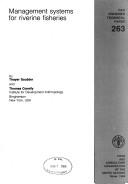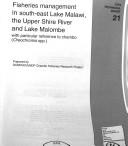| Listing 1 - 10 of 954 | << page >> |
Sort by
|
Book
Year: 1976 Publisher: Rome Food and Agriculture Organization of the United Nations
Abstract | Keywords | Export | Availability | Bookmark
 Loading...
Loading...Choose an application
- Reference Manager
- EndNote
- RefWorks (Direct export to RefWorks)
Book
ISBN: 9264855335 Year: 2023 Publisher: Paris : Organization for Economic Cooperation & Development,
Abstract | Keywords | Export | Availability | Bookmark
 Loading...
Loading...Choose an application
- Reference Manager
- EndNote
- RefWorks (Direct export to RefWorks)
L'Examen de l'OCDE des pêcheries 2022 rassemble des données sur la gestion des pêches et les mesures de soutien connexes, qui y sont analysées afin d'éclairer la prise de décisions en faveur d'une pêche durable et résiliente, qui soit source d'emplois, d'alimentation et de revenus pour les générations à venir. Y sont évalués l'état de santé et la productivité des stocks halieutiques, et étudiés les moyens de mieux les gérer.
Periodical
Abstract | Keywords | Export | Availability | Bookmark
 Loading...
Loading...Choose an application
- Reference Manager
- EndNote
- RefWorks (Direct export to RefWorks)
Book
Year: 2013 Publisher: Copenhagen : Nordisk Ministerråd : Nordisk Råd,
Abstract | Keywords | Export | Availability | Bookmark
 Loading...
Loading...Choose an application
- Reference Manager
- EndNote
- RefWorks (Direct export to RefWorks)
The report describes a framework that can be used to identify the most important trade-offs in ecosystem based fisheries management. The framework contains a description of how to identify the border between the science and policy domains, how to identify objectives and set goals for management, and how to communicate the management advice. Consultations with stakeholders showed that multi-species management advice needs to be precautionary, provide yields close to MSY, be in accordance with ecosystem constraints and be possible to communicate clearly to managers and policymakers. The use of the framework is demonstrated through examples from three different ecosystems: the Baltic Sea, the North Sea and the Barents Sea.
Book
Year: 2023 Publisher: Basel : MDPI - Multidisciplinary Digital Publishing Institute,
Abstract | Keywords | Export | Availability | Bookmark
 Loading...
Loading...Choose an application
- Reference Manager
- EndNote
- RefWorks (Direct export to RefWorks)
Marine environmental conditions are very distinct in the Yellow Sea, the East China Sea, and the East/Japan Sea. Physico-chemical properties and subsequently biological characteristics are different among the three seas. During the recent decades, dramatic changes in physical structure and vertical distribution of chemical properties were reported in the Yellow Sea, the East China Sea, and the East/Japan Sea. However, we do not know much about the current status of the marine ecosystems in these three distinct seas to date. Since 2018, the integrated ecosystem assessment for ecosystem-based fisheries management have been implemented in the Yellow Sea, the East China Sea, and the East/Japan Sea by the National Institute of Fisheries Science, Korea. This special volume will provide basic information for the current status of the marine ecosystems and an important background for the future monitoring of marine ecosystem responses to ongoing climate changes in the Yellow Sea, the East China Sea, and the East/Japan Sea.
Book
Abstract | Keywords | Export | Availability | Bookmark
 Loading...
Loading...Choose an application
- Reference Manager
- EndNote
- RefWorks (Direct export to RefWorks)
The purpose of these guidelines is to aid stakeholders and fisheries managers in the development of national and regional plans of action for the management of fishing capacities, in order to align fishing capacity with the sustainable use of fish stocks.--Publisher's description.
Book
Year: 1985 Publisher: [Seattle, Wash.] : National Oceanic and Atmospheric Administration, National Marine Fisheries Service, Southwest Fisheries Center,
Abstract | Keywords | Export | Availability | Bookmark
 Loading...
Loading...Choose an application
- Reference Manager
- EndNote
- RefWorks (Direct export to RefWorks)

Abstract | Keywords | Export | Availability | Bookmark
 Loading...
Loading...Choose an application
- Reference Manager
- EndNote
- RefWorks (Direct export to RefWorks)
Book
Year: 2023 Publisher: Basel : MDPI - Multidisciplinary Digital Publishing Institute,
Abstract | Keywords | Export | Availability | Bookmark
 Loading...
Loading...Choose an application
- Reference Manager
- EndNote
- RefWorks (Direct export to RefWorks)
Marine environmental conditions are very distinct in the Yellow Sea, the East China Sea, and the East/Japan Sea. Physico-chemical properties and subsequently biological characteristics are different among the three seas. During the recent decades, dramatic changes in physical structure and vertical distribution of chemical properties were reported in the Yellow Sea, the East China Sea, and the East/Japan Sea. However, we do not know much about the current status of the marine ecosystems in these three distinct seas to date. Since 2018, the integrated ecosystem assessment for ecosystem-based fisheries management have been implemented in the Yellow Sea, the East China Sea, and the East/Japan Sea by the National Institute of Fisheries Science, Korea. This special volume will provide basic information for the current status of the marine ecosystems and an important background for the future monitoring of marine ecosystem responses to ongoing climate changes in the Yellow Sea, the East China Sea, and the East/Japan Sea.

ISBN: 9251032416 Year: 1993 Publisher: Rome FAO
Abstract | Keywords | Export | Availability | Bookmark
 Loading...
Loading...Choose an application
- Reference Manager
- EndNote
- RefWorks (Direct export to RefWorks)
| Listing 1 - 10 of 954 | << page >> |
Sort by
|

 Search
Search Feedback
Feedback About UniCat
About UniCat  Help
Help News
News